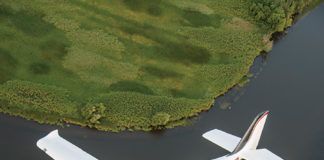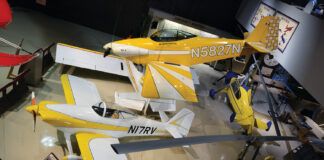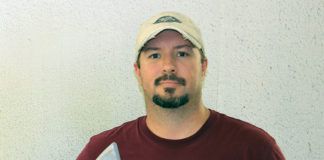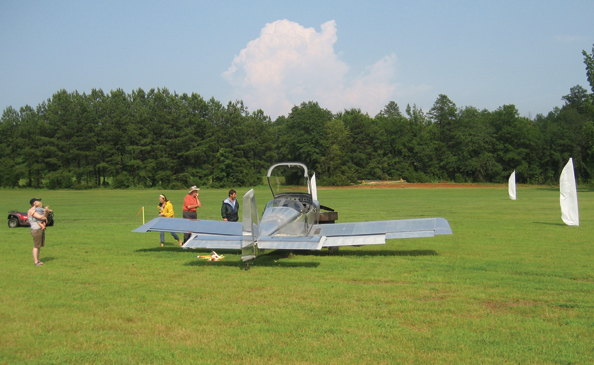
As we were rolling out after landing my Van’s RV-9, I keyed the mic and inquired over the Unicom which taxiway I should take and where I should park. “Take a left at Bravo and park along the trees with the other planes,” was the reply.
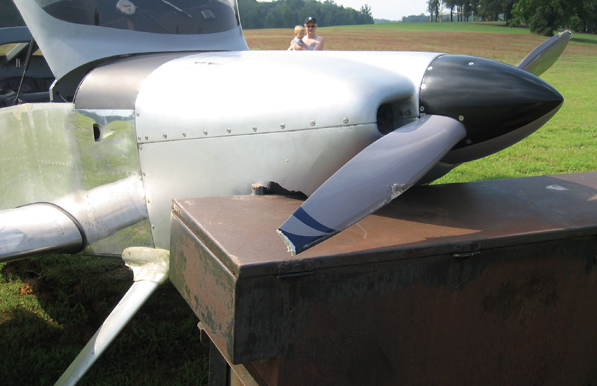
The propeller struck the trailer three times. Note the approximately 2 inches of missing prop tip and the gouge farther up the blade from strikes No. 1 and No. 3.
After turning up the taxiway, a group of friends walked over and waved us down, so we stopped. I popped the top and had a brief conversation about where to park. The taxiway was marked on either side with tall poles that precluded S-turning. I motored up the hill toward the trees where I could see the wings of a number of Cessnas and miscellaneous other high-wing planes.
Just as we crested the small hill it happened: Kerpow! Then silence, well, after some loud cursing there was silence.
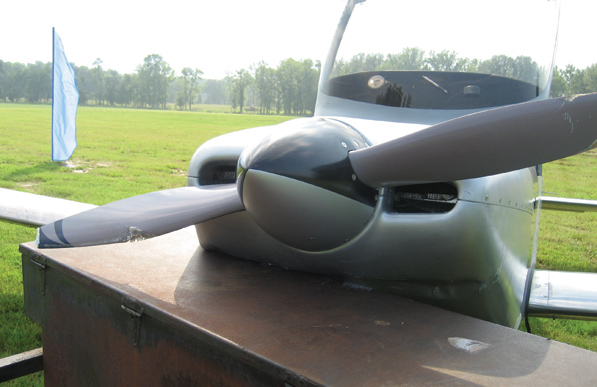
How much damage can there be? An engine overhaul and a little bit of fiberglass work, that’s all. Wrong!
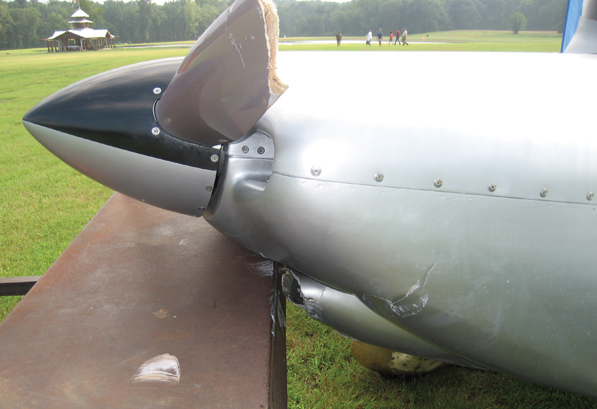
This blade suffered the second strike, before the catastrophic third hit halted the engine and damaged the crankshaft.
What Was That?
As I was turning off the switches and fuel I looked to my wife and asked if she could see what we hit, as there was nothing to be seen on my side. “No, I can’t see a thing,” she said. That brief conversation was followed by firm instructions to my wife to exit the plane as fast as she could. With this she looked over and asked why. My one word response got her moving quicker than Bubba at a barbecue fest: “Fire.” Luckily for us, there was no fire, but from our seats there was no way to know for sure, and it was prudent to exit the plane as quickly as possible.
After deplaning and walking around the front of the aircraft it became obvious what had happened. The nose of the plane was sitting on top of a landscape trailer, tongue centered between the gear legs. The combination of a low trailer left in the middle of a taxiway lined with poles, a small hill and the natural ground stance of a taildragger stacked the cards against me.
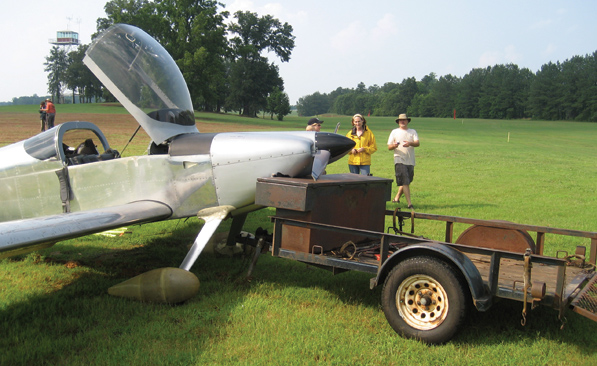
The sun is out, but the author’s flying forecast is still murky.
In the Aftermath
The taxi incident was followed by numerous telephone calls. The FAA wasn’t interested in a minor incident—there was no injury and the airplane was not “substantially” damaged—so most of my focus was in dealing with my insurance company. A week after the incident the insurance investigator inspected the aircraft, took pictures and a statement, and made copies of the aircraft logbooks, my logbook, my pilot license and medical. That was followed by disassembly and transport of the plane back to my basement workshop.
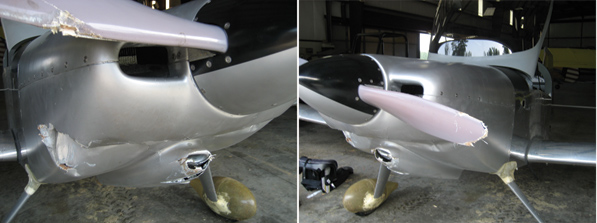
After towing the plane to the only hangar on the field, it was time to perform the initial inspection. The intake is crushed and the damaged propeller is clearly visible, but what else?
As with any type of insurance you only “win” when you “lose,” and in this case, I had just suffered a big loss. The initial telephone conversation with the insurance investigator went something like this: “Did you have a composite prop on your aircraft? Many times owners of Experimentals will just bolt a new prop on and fly it home after a prop strike.” Whoa, that was not the response I was looking for. At the time of that conversation I didn’t know the extent of the damage, but I knew it was not going to be that simple. After all, the incident turned my “outty” into an “inny,” and there was no way this plane was going to fly anytime soon.
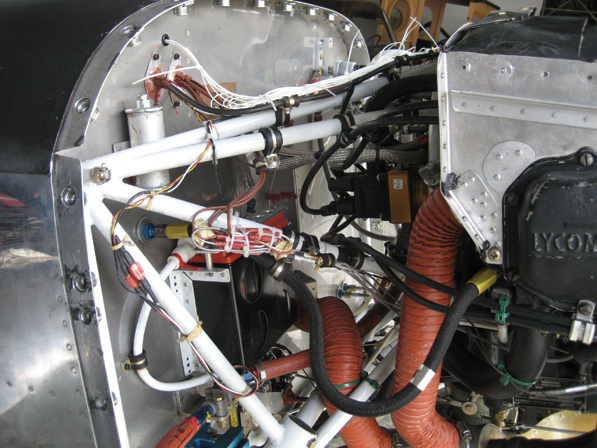
The cowling is removed, and the engine mount and firewall look to be intact. Or are they? The firewall was fine, but the insurance investigator pointed out two small cracks in the engine mount, located on the upper crossover tube.
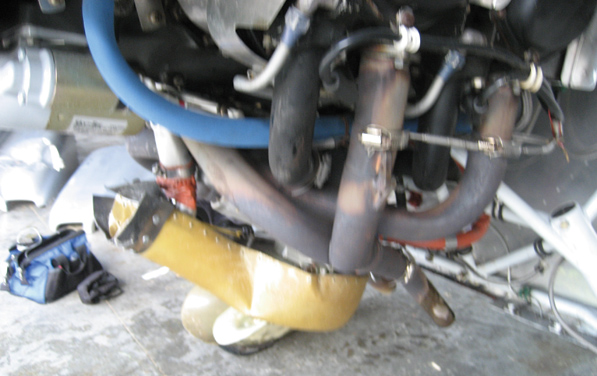
The filtered air box (FAB) is damaged, as are the exhaust and intake runners.
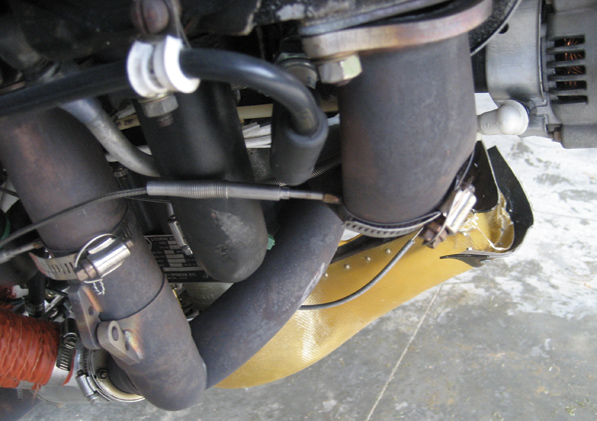
The exhaust flange on cylinder No. 1 is pulled away from the exhaust port, possibly damaging the cylinder where the studs are screwed into the aluminum head.
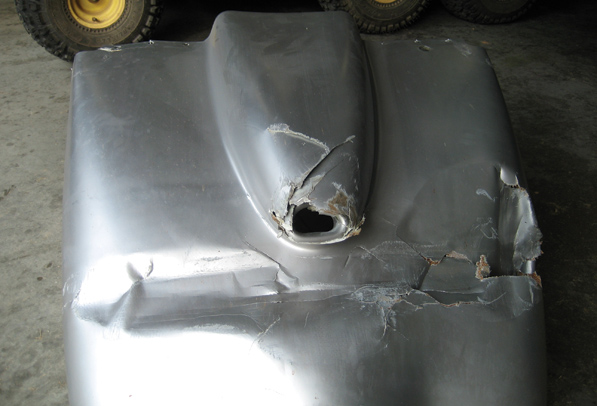
The author doesn’t mind doing fiberglass work, but this is just sad.
Back in my shop, the engine was “dialed” by an A&P mechanic and found to be well outside the service limits set by Lycoming. With that information in hand and a complete inspection of the damage, an extensive parts list was compiled and turned into the insurance company. The list included every damaged part: nuts, bolts, hose clamps, etc. and the cost of each item.
In hindsight we were lucky that no one was injured inside or outside the plane. Only the firewall-forward components were damaged, and not a single metal skin on the RV-9 was dented or wrinkled. Thus, the repairs would not entail any sheet-metal work. Great, fiberglass work. Again.
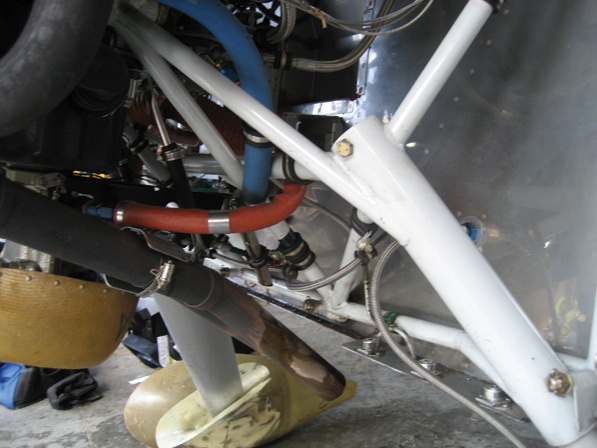
The firewall was not damaged, but everything forward of that would need to be replaced.

Cylinder No. 2’s intake tube is dented. (The blue hose is the breather line for the O-290-D2.)
Two days shy of the three-month anniversary of the taxi incident the first of two checks arrived in my mailbox. After the plane is flying again, a second check will be cut to cover the cost of additional parts and my labor. That is correct: They are going to pay me to fix my airplane.
Why so long to write the first check? My plane was equipped with a Lycoming O-290-D2 that was last produced in the 1950s. This particular engine had less than 1000 hours total time and less than 250 hours since major overhaul. The airplane took a month to get disassembled and inspected, and then the insurance company spent two months looking into the costs of overhauling my old engine. The adjusters found the cost of purchasing suitable parts was prohibitively expensive. All told, the cost of overhauling that engine would be more than the purchase price of a new, current production engine.
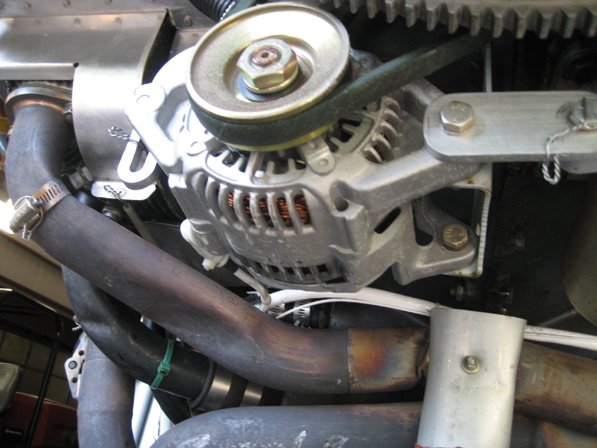
The alternator was damaged, and was subsequently replaced along with the engine. The crossover exhaust and carburetor heater muff were crushed against the sump. Also visible in this photo is the damaged intake runner for cylinder No. 1.
With that information in hand, the insurance investigator called, and an amicable settlement was reached, followed by a check a week later.
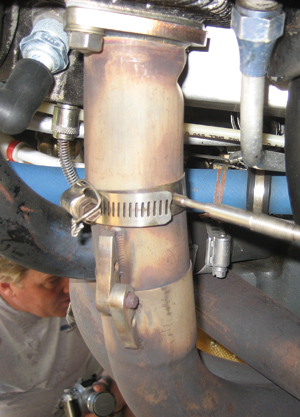
The exhaust as it exits cylinder No. 2 is bent aft. A hacksaw was employed to remove it from the O-290.
Check in hand, it was time for me to make all of those decisions again. You know, the kind of decisions that all builders go through while building. Which engine, fuel injection or carbureted? The check wasn’t large enough to cover the custom-built, fuel-injected, hotrod engine with a constant-speed prop that I had been dreaming about since the incident, so it was on to Plan B: order an Engine Components, Inc. kit engine.
But what size? The RV-9 was designed for three Lycoming engines: the O-235, O-290 and O-320. Put another way, it could accommodate 118 to 160 horsepower. After electing to build up my own ECi engine kit (www.eci.aero/exp/index_exp.aspx), selecting which kit engine proved to be more difficult than I had imagined. ECi offers both injected and carbureted engines, which left me scratching my head until I finally realized that my wallet was going to draw the modification line somewhere, so carbureted it would be. The next question was 160-hp O-320 or 180-hp O-360? My RV-9 had an empty weight of 990 pounds with a wood composite propeller and the O-290-D2. This combination flew well, had a good climb rate, reasonable cruise speed and a generous useful load of 760 pounds. Maintaining a low empty weight was a concern for me, though I knew the plane, like me, was going to gain a few pounds. But how many?

The exhaust, carburetor heat muff, and filtered air box were crushed against the oil sump. After the airplane was returned to the author’s basement workshop, the engine was leaking oil, which it had not done previously. It is believed the impact may have cracked the oil sump.
Check the Numbers
Comparing engine weight, size and, finally, cost narrowed my selection to the 164-hp O-320, 175-hp O-340 and 185-hp O-360. (Horsepower numbers are taken from the ECi web site.) The listed weights of the three engines are 270, 277 and 282 pounds, respectively, and the cost difference was minimal, with the O-340 kit costing $100 more than the O-360 kit, which was $500 more than the O-320 kit. After looking over the numbers, there wasn’t enough difference in cost or weight to drive me away from the larger engine, so the O-360 it will be. As they say, there is no replacement for displacement. For comparison, the O-290-D2 tipped the scales at 264 pounds; its replacement would net a gain of 18 pounds.
With the engine choice made, propeller selection was next. After those two items are out of the way, the rest is just parts and pieces. Well, almost. The O-290 spun a 9-pound Catto wood composite two-blade fixed pitch prop with a 68-inch diameter a 64-inch pitch. As is typical of wood composite propellers, the engine was smooth while providing reasonable performance. (There will be more on the performance of this engine-prop combination in a future story.) It was my desire to remain with a fixed-pitch composite propeller, but which one? The reason for eliminating the constant-speed prop was part cost, part simplicity, part weight, but mostly I did not want to have to cut up my panel to fit a three-lever throttle quadrant to replace the two-lever quadrant that is currently installed.
The Catto is a nice propeller, but I keep dreaming about doing speed mods in the future. If that was going to be the case, I would have to replace the propeller every time I made a change, so that seemed to be out. Sensenich has been developing a ground-adjustable propeller for the larger four-cylinder Lycoming engines for the past few years. Unfortunately, due to some development issues, it has been delayed. Whirlwind also makes an 18-pound ground-adjustable composite propeller, which looked good at first glance.
When it came to writing that check, I had to think twice about running a new propeller with limited service experience, not to mention adding more weight on the nose. With that in mind, I picked up the telephone and ordered another propeller from Craig Catto. Total weight gain at this juncture is expected to be around 20 pounds—18 for the new engine and an estimated 2 additional pounds for the larger prop.
With the engine and propeller selected there was still one major choice to be made. To cover that larger engine I contacted father-and-son team Sam and Will James and ordered a cooling plenum and their Holy Cowl. The cowl was selected for purely aesthetic reasons, while the cooling plenum was picked to help balance the CHTs and maybe, just maybe, the combination will help me pick up a bit of speed.
That’s where we will conclude with this installment. Next month, I’ll get into the nitty-gritty of the repair process. You’d be amazed how much different it feels to be repairing compared to building or maintaining.

![]()
Bill Repucci was handed his Private Pilot’s certificate back in the days when the written test was taken with a Number 2 pencil. At the time, Bill was told that he now had a “License to Learn.” And learn he did, mostly that there was humor buried in the quirky ways of those of us who call ourselves aviators.

